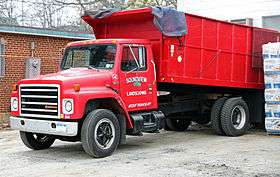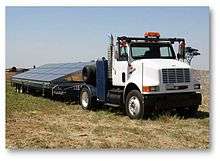International Harvester S-Series
| International Harvester S-Series | |
|---|---|
 1989 International S-1700 single-axle dump truck | |
| Overview | |
| Manufacturer |
International Harvester (1978-1986) Navistar International (1986-2001) |
| Also called |
Navistar International 4000-Series Navistar International 8000-Series |
| Production | 1977-2001 |
| Body and chassis | |
| Class | Class 6-7 medium-duty truck |
| Body style |
|
| Layout |
4x2 6x4 |
| Related |
International S-Series "Schoolmaster" International 3800 |
| Powertrain | |
| Engine |
Gasoline 197–236 hp (147–176 kW) Diesel 150–500 hp (110–370 kW) |
| Transmission |
Manual Automatic |
| Chronology | |
| Predecessor |
International Harvester Fleetstar (to 1978) International Harvester Loadstar (1962-1979) |
| Successor | International 4000-Series/DuraStar |
The International Harvester S-Series is a medium and heavy-duty truck line that was manufactured by International Harvester. "S-Series" was first used as a label for the 1956 and 1957 Light Line trucks, until replaced by the A-series for 1958. The S-series label was reintroduced in mid-1977 as a replacement for the International Harvester Fleetstar. In 1979, other versions of the S-Series were introduced to succeed the Loadstar-series. Like the Loadstar, the S-Series were straight trucks commonly used for local delivery; the versions replacing the Fleetstar were semi-tractors or severe-service straight trucks. Additionally, the S-Series (and its replacement, the 3800) proved popular in the school bus industry. The S-Series was the last product line designed from the ground up by International Harvester themselves; it was produced in its original form until the end of the 1980s. Production of the second-generation S-Series ended in 2001.
S-Series (1955-1957)

The origins of the S-Series nameplate date to 1955, when International Harvester introduced a successor to the R-Series for the 1956 model year. This S-Series was available primarily as light-duty (pickup) and medium-duty trucks, as the R-series of heavier trucks continued largely unchanged. Nonetheless, the heaviest versions (like the S-1840) had gross vehicle weights of 24,000 lb (10,890 kg) and 308 ci "Black Diamond" engines.[1] Production of the light duty S-Series ended in 1957, when it was replaced by the A-series.[2] As with its predecessor the R-series, the "S" also formed the basis of a full-size station wagon called the Travelall.
The S-184 heavy version was produced in Brazil by International's Brazilian subsidiary, until Chrysler bought it in 1966.[3]
First generation (1978-1989)
In April 1977, International Harvester unveiled the medium-duty S-Series at an event at the New Orleans Superdome.[4] Initial sales were of heavier-duty 2200, 2500, and 2600 models (28,000-45,000 lb GVW[lower-alpha 1]), replacing the Fleetstar. In the summer of 1978,[5] lighter-GVWR models (replacing the Loadstar) were released for sale.
Following the discontinuation of the IHC pickup-truck line in 1975, the S-Series was designed with a model-specific cab, replacing the pickup-truck cab used for the Loadstar (designed for the 1957 A-Series). More vertically-oriented than its predecessor, the design was much wider as well. To lower maintenance costs, all windows in the cab were designed with flat glass, including the windshield. Similar in style to the tilting hood introduced for the Loadstar in 1972, all S-Series trucks were given a tilting fiberglass hood.
The S-Series would be produced throughout the 1980s largely unmodified. 1987 would mark several changes to the S-Series trucks. To reflect the corporate change of the company from International Harvester to Navistar International, S-Series trucks saw changes in their badging (alongside all International vehicles). On the grille, the word "International" across the top of the grille was replaced by a red Navistar "diamond" logo alongside "International" in red at the bottom left of the grille. Inside, the IHC "tractor" logo on the steering wheel was replaced by a Navistar diamond logo. In a major shift, for 1987, International became the first truck manufacturer to produce a medium-duty product line powered exclusively by diesel engines.
Models
Originally intended to use the International Tristar nameplate, the S-Series consolidated the aging Loadstar and Fleetstar trucks under a single product line. Tandem-axle (6x4) versions of the S-Series were named F-series trucks.[6]
1978-1983 models
| Model[7] | Max. front GAWR[lower-alpha 2] | Max. rear GAWR | Engine[lower-alpha 3] | Trans [lower-alpha 4] |
|---|---|---|---|---|
| 1600 4x2 | 5,000 lb (2,300 kg) | 15,000 lb (6,800 kg) | V-345 | 5M, 4A |
| Binder 4x2 | 1,600 lb (730 kg) | 15,000 lb (6,800 kg) | V-345 | 5M, 4A |
| 1700 4x2 | 7,500 lb (3,400 kg) | 15,500 lb (7,000 kg) | MV-404, D-170 | 10M, 5A |
| 1800 4x2 | 6,000 lb (2,700 kg) | 15,500 lb (7,000 kg) | MV-446, DT-466 | 13M, 5A |
| 1800 4x4 | 9,000 lb (4,100 kg) | 15,500 lb (7,000 kg) | MV-446, DT-466 | 5M, 4A |
| 1900 4x2 | 9,000 lb (4,100 kg) | 17,500 lb (7,900 kg) | MV-446, DT-466 | 10M, 5A |
| 1900 6x4 | 9,000 lb (4,100 kg) | 34,000 lb (15,000 kg) | MV-466, DT-466 | 10M, 5A |
| 1900 6x6 | 9,000 lb (4,100 kg) | 34,000 lb (15,000 kg) | MV-466, DT-466 | 5M |
| 2100 4x2 | 9,000 lb (4,100 kg) | 17,500 lb (7,900 kg) | V-537, DT-466 | 10M |
| 2100 6x4 | 9,000 lb (4,100 kg) | 34,000 lb (15,000 kg) | V-537, DT-466 | 10M |
| 2200 4x2 | 10,800 lb (4,900 kg) | 23,000 lb (10,000 kg) | Cat 3406 | 13M |
| 2200 6X4 | 12,000 lb (5,400 kg) | 23,000 lb (10,000 kg) | Cat 3406 | 13M |
| 2500 4x2 | 16,000 lb (7,300 kg) | 29,000 lb (13,000 kg) | Cat 3406 | 13M |
| 2500 6X4 | 18,000 lb (8,200 kg) | 44,000 lb (20,000 kg) | Cat 3406 | 13M |
| 2600 4x2 | 16,000 lb (7,300 kg) | 29,000 lb (13,000 kg) | Cum PT | 13M |
| 2600 6X4 | 18,000 lb (8,200 kg) | 44,000 lb (20,000 kg) | Cum PT | 13M |
Second generation (1989-2001)
During 1989 production, the International S-Series underwent a major redesign. In the interest of the aerodynamics, the truck was given a lower hoodline with smoother contours to the hood and fenders. In the interest of functionality, the interior controls were completely redesigned, with a new dashboard; a two-spoke steering wheel replaced the previous three-spoke design.
Although the exterior design was well-received, the interior saw several updates (replacing the instrument panel in 1992 and redesigning the rest of the interior in 1995). The second-generation models would remain in production until the end of the 2001 model year.
Models

For 1989, the S-Series naming scheme was updated, partially to reflect the redesign and in favor of the change from International Harvester to Navistar International. Bus chassis were changed from the traditional IHC xxx3 suffix to 3000-Series. Class 5-7 trucks (the previous S1600-1800) were rechristened the 4000-Series. Class 7-8 trucks (the previous S/F 1900 and above) were re-christened the 8000-series. The 8100 was a short-hood tractor, while the 8200 and 8300 were long-hood tractors designed similar to the aerodynamic 9400 Class 8 tractor.
Dropping their S-Series prefix, the popular 2500 and 2600 trucks continued in production as severe service vehicles, slotted below the Paystar in size.
2002 Models
| Model[8] | Max. front GAWR[lower-alpha 2] | Max. rear GAWR | Max. GVWR[lower-alpha 1] | Engine[lower-alpha 5] | Trans[lower-alpha 4] |
|---|---|---|---|---|---|
| 4200 | 12,000 lb (5,400 kg) | 23,000 lb (10,000 kg) | 35,000 lb (16,000 kg) | VT 365 | 6M, auto |
| 4300 | 14,000 lb (6,400 kg) | 24,000 lb (11,000 kg) | 37,000 lb (17,000 kg) | DT 466 | 6M, auto |
| 4400 | 14,000 lb (6,400 kg) | 26,000 lb (12,000 kg) | 40,000 lb (18,000 kg) | DT 530 | 6M, auto |
| 4400 6x4 | 14,000 lb (6,400 kg) | 40,000 lb (18,000 kg) | 54,000 lb (24,000 kg) | DT 530 | 6M, auto |
| Model | Replaced | Notes |
|---|---|---|
| 4500 | S1600 | Low-profile chassis |
| 4600 | ||
| 4700 | Low-profile chassis | |
| 4900 | S1800 | Available with tandem rear axles. |
| 8100 | S1900 | |
| 8200 | Long hood semi-tractor | |
| 8300 | Long hood semi-tractor | |
| 2500 | Long hood | |
| 2600 | Long hood, set-back front axle Available in 4x2, 4x4, 6x4, and 6x6 drive | |
| 3600 | Australasia-specific model, similar to 2500 model-specific hood |
Bus use


Throughout its production, the S-Series would be used as a cowled chassis for bus manufacturers. While used primarily for yellow school buses in the United States and Canada, the S-Series also was used outside of North America as a basis to produce other types of bus bodies. Introduced in 1979, the bus variant of the S-Series would be one of the final models designed by International Harvester before its transition to Navistar. In 1989, the S-Series bus chassis was rechristened the 3000-Series with the fitment of the new-generation Navistar cowl.
Produced until 2004, the bus chassis would outlive its truck counterpart by three years; its 25-year production run is the longest of any product ever sold by International Harvester or Navistar.
Models
| Models | Replaced | Notes |
|---|---|---|
| S-1700
S-1800 |
Loadstar 1703
Loadstar 1803 |
|
| 3600 | See Thomas Vista
Produced 1992-1998 | |
| 3700
3800 |
S1700
S1800 |
Powertrain
| Model[lower-alpha 6] | Displacement | Type[lower-alpha 7] | Power | Torque |
|---|---|---|---|---|
| V-345 | 345 cu in (5.7 l) | G V8 | 197 hp (147 kW) | 309 lb·ft (419 N·m) |
| V-392 | 392 cu in (6.4 l) | G V8 | 236 hp (176 kW) | |
| MV-404 | 404 cu in (6.6 l) | G V8 | 210 hp (160 kW) | 336 lb·ft (456 N·m) |
| MV-446 | 446 cu in (7.3 l) | G V8 | 235 hp (175 kW) | |
| D-190 | 549 cu in (9.0 l) | D V8 | 190 hp (140 kW) | 340 lb·ft (460 N·m) |
| IDI-420 | 420 cu in (6.9 l) | D V8 | 170 hp (130 kW) | |
| IDI-444 | 440 cu in (7.2 l) | D V8 | 190 hp (140 kW) | 388 lb·ft (526 N·m) |
| Cat 3208 | 636 cu in (10.4 l) | D V8 | 210 hp (160 kW) | |
| Cat 3406 | 893 cu in (14.6 l) | D I6 | 380 hp (280 kW) | |
| Cum NTC-350 | 855 cu in (14.0 l) | D I6 | 350 hp (260 kW) | |
| Cum M11 | 659 cu in (10.8 l) | D I6 | 500 hp (370 kW) | 1,550 lb·ft (2,100 N·m) |
| DD 6-71 | 426 cu in (7.0 l) | D I6 | 230 hp (170 kW) | |
| DD 6V-92 | 552 cu in (9.0 l) | D V6 | 335 hp (250 kW) | |
| DD 8V-92 | 736 cu in (12.1 l) | D V8 | 400 hp (300 kW) |
See also
| Wikimedia Commons has media related to International Harvester S-Series. |
Notes
- 1 2 Gross Vehicle Weight Rating is the loaded weight of the truck.
- 1 2 Gross Axle Weight Rating is the loaded weight of the axle.
- ↑ Highest rated gasoline, diesel engine.
- 1 2 Speeds in manual(M), automatic(A) transmission
- ↑ Highest rated engine.
- ↑ Engines are International unless noted as Caterpillar(Cat), Cummins(Cum), or Detroit Diesel(DD).
- ↑ Gasoline(G), diesel(D), inline(I), (V), and number of cylinders.
References
- ↑ Crismon, Frederick W. (2002), International Trucks (2 ed.), Minneapolis, MN: Victory WW2 Publishing, p. 272, ISBN 0-9700567-2-9
- ↑ "International Harvester History: Trucks". International Harvester. 1961.
- ↑ Shapiro, Helen (Winter 1991). "Determinants of Firm Entry into the Brazilian Automobile Manufacturing Industry, 1956-1968". The Business History Review. 65 (4, The Automobile Industry): 879. doi:10.2307/3117267.
- ↑ Crismon, p. 485
- ↑ Crismon, p. 492
- ↑ Crismon, p. 495
- ↑ "International Truck Specifications - S Line". Wisconsin Historical Society. 2013. Retrieved 2014-10-28.
- ↑ "International 4000 Series sales brocure" (PDF). International Truck and Engine. 2002. Retrieved 16 Aug 2016.
- American Truck & Bus Spotter's Guide: 1920-1985, by Tad Burness.
- International Trucks, by Frederick W. Crismon
External links
- International Harvester S-Series (Internet Movie Cars Database)
- Russell MacNeil photo, July 6, 2005 (Hank's Truck Pictures)